Chinese Pond Heron Ardeola bacchus 池鷺
Category I. Common at a variety of freshwater and brackish wetlands across HK throughout the year; both migratory and resident populations occur.
IDENTIFICATION
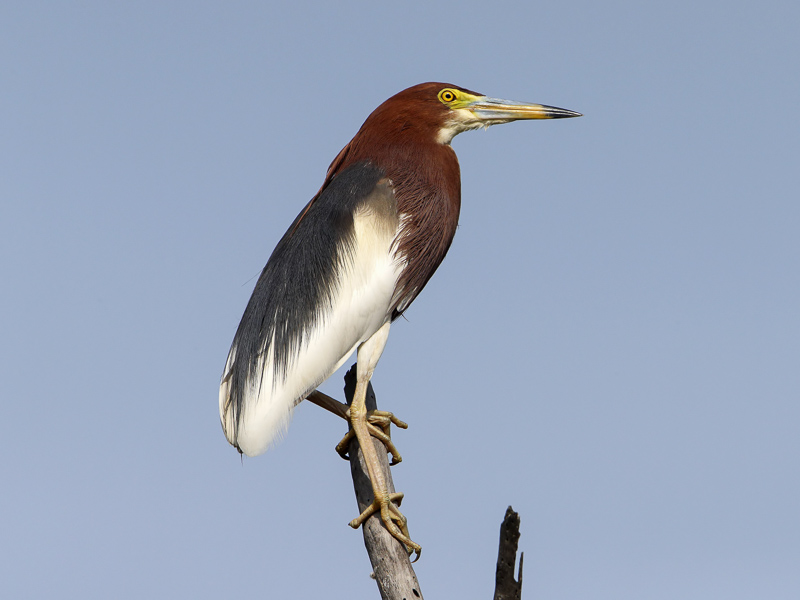
May 2015, Paul Leader. Adult, breeding plumage.
42-52 cm. Small heron with relatively large bill and feet; in all plumages when birds take flight sudden appearance of white wings is striking.
Adults in breeding plumage have dark vinous head and chest darkening to a dark greyish on the lower chest and scapulars. Rest of underparts, wing coverts, upperwings and tail are white. Bill orange-yellow tipped black, legs orange-yellow with reddish bases at peak of breeding condition.
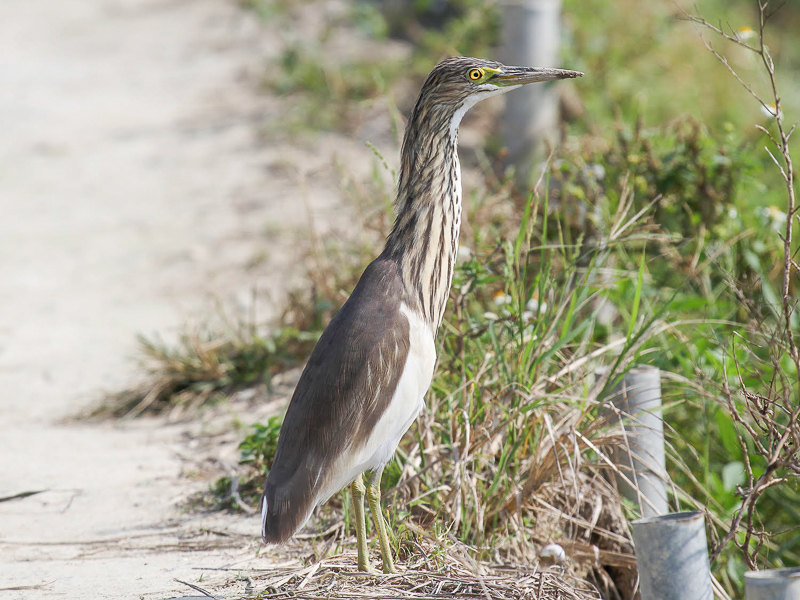
Jan. 2015, CHUNG Yun Tak. Non-breeding.
In non-breeding and immature plumages has broad brown streaks on head and chest, plain brown upperparts and largely dark bill. First-year birds have fairly extensive if patchy pale brownish across the upperwings and tail tip, while adults have only diffuse darker tips to outer two primaries.
VOCALISATIONS
The call heard when a bird is flushed tends to be deep and throaty with a rattling quality and is repeated. A similar call is uttered singly by nocturnal migrants.
The relaxed diurnal flight call is higher pitched and thinner.
DISTRIBUTION & HABITAT PREFERENCE
Chinese Pond Heron is particularly common in the New Territories, especially around Deep Bay and Starling Inlet, but there are only occasional records from Kowloon and HK Island. It can be found in almost any low-lying damp area, as well as at ornamental lakes in parks and gardens.
OCCURRENCE
The pattern of occurrence through the year in the Deep Bay area since 1998 as recorded by monthly waterbird counts indicates highest numbers occur from July to November (Figure 1), which is presumed to be due to the presence of both migrant and locally-bred birds. Numbers decline from January to a low in April, due presumably to northward departure of wintering birds and the breeding population not yet being established.
The peak coordinated count each winter since 1979 is presented in Figure 2. There was a decline from a peak of 538 in Hong Kong (684 in all of Deep Bay) on 13 January 1990 to 113 (plus a further three at Fu Tian) in winter 2010/11. Since then, however, there has been an increase to counts in the region of 400 in the five winter periods from 2016/17 (the highest being 475 on 18 December 2016 with a further 47 at Fu Tian). Based on winter waterbird counts in Deep Bay Sung et al. (2021) concluded that the wintering population increased from 1998 to 2017.
While Vaughan and Jones (1913) reported that the local population of Chinese Pond Herons was swelled by migrants from the north, Macfarlane and Macdonald (1966) considered the species to be a resident. Herklots (1953, 1967), however, suggested that there was a breeding population that arrived in the last week of March and remained until as late as October before migrating south for the winter. In summer, he estimated that it was the commonest of all the ardeids in HK.
On Po Toi, where Chinese Pond Heron is a migrant, birds have been noted from 3 April to 31 May (highest count 91 on 16 April) and 2 September to 14 November (116 on 21 September). At Kai Tak in the 1970s it was recorded from 9 April to 28 May (Melville 1980). Nocturnal migrants over Pak Sha O, Sai Kung have been recorded from 3 September to 1 November.
On 13 July 1995, a coordinated Deep Bay count recorded 613 Chinese Pond Herons, compared with totals of 337 and 197 in the January waterbird counts of 1995 and 1996, respectively. While this indicates that the arrival of summer visitors may swell the local population at this time, it may not be to the extent that is indicated by these figures. Comparisons of the number of Chinese Pond Herons during different seasons is difficult because in summer the species breeds in conspicuous colonies, making counting relatively easy, while at other times the species is more widely dispersed, and so undercounting is likely.
BREEDING
The number of breeding pairs present has fluctuated due to changes in land use and human disturbance at breeding colonies (Murton 1972, Young and Cha 1995). An annual average of 140 pairs were recorded during 1958-67. However, Macfarlane and Macdonald (1966) reported that the only breeding colony of Chinese Pond Herons at the time was at Sha Tau Kok (Yim Tso Ha), since all other sites had been deserted due to typhoon damage.
Subsequently, there was a decline to an average of 78 pairs per year during 1968-1977, even though fish pond area reached a peak of 2,255 ha in 1971. It is possible that the reduction was due to a change in agricultural land use from wet paddy to dry agriculture in certain areas. Wet paddy was a favoured feeding habitat for Chinese Pond Herons, as the two-crop system employed resulted in two peaks in abundance of aquatic prey for ardeids (Murton 1972). With the change in land use, however, this feeding habitat disappeared, as did the associated breeding colonies, except for that at Yim Tso Ha (Thrower 1984).
During the period 1989-2000 an average of 133 breeding pairs per year were noted. Since 2000 the number of nests has increased substantially, with the 2012-21 ten-year mean nest count being 353. This increase is confined to the Deep Bay area (Figure 3), where the largest colonies are in the vicinity of Mai Po village. Winter waterbird counts have also recorded an increase in numbers since 2014. The reason for this trend is unclear, though it is happening despite the area of fish ponds in 2021 being approximately half what it was 50 years previously when the number of breeding pairs was substantially lower. Young (1994) found that the number of Chinese Pond Herons appears to depend to some extent at least on the aggregate length of fish pond perimeter present.
As the number of breeding birds has fluctuated over the past 40 years, so has the location of colonies. In the late 1950s when records began, most of the colonies were situated in the Yuen Long area. This was no doubt because there were still large areas of suitable wetland feeding habitats nearby at the time. Apart from two to the north and south of Yuen Long, there were also colonies at Ping Shan (60 nests in 1960), Wong Uk (100 nests in 1958) and Shan Pui (50 nests in 1958). All of these sites are now developed. Presently, colonies supporting Chinese Pond Herons are concentrated in the Deep Bay area, with less than 20% of nests away from there.
BEHAVIOUR, FORAGING & DIET
Chinese Pond Heron been recorded eating fish (including Mosquito Fish Gambusia affinis), Swampy Eel Monopterus albus, frogs, shrimps and dragonflies; also flies that gather around piles of dead fish left to decompose around the pond edges (Melville 1987) and insects in trees (Melville 1990). One was also recorded eating a Barn Swallow (Melville 1995).
An unobtrusive usually solitary heron that suddenly announces its presence with a flash of white as it takes flight uttering a quiet rather throaty call. However, at favoured ponds or foraging sites loose groups of birds may be flushed one by one.
RANGE & SYSTEMATICS
Monotypic. Breeds in Ussuriland, Japan, the Korean peninsula and much of lowland China including Hainan and Taiwan into north Vietnam; the bulk of the population is migratory, wintering in coastal provinces of south China south through Indochina to Sumatra and Borneo (Martínez-Vilalta et al. 2020). In China present all year in southern coastal provinces (Liu and Chen 2020).
CONSERVATION STATUS
IUCN: Least Concern. Population trend stable.
Figure 1.
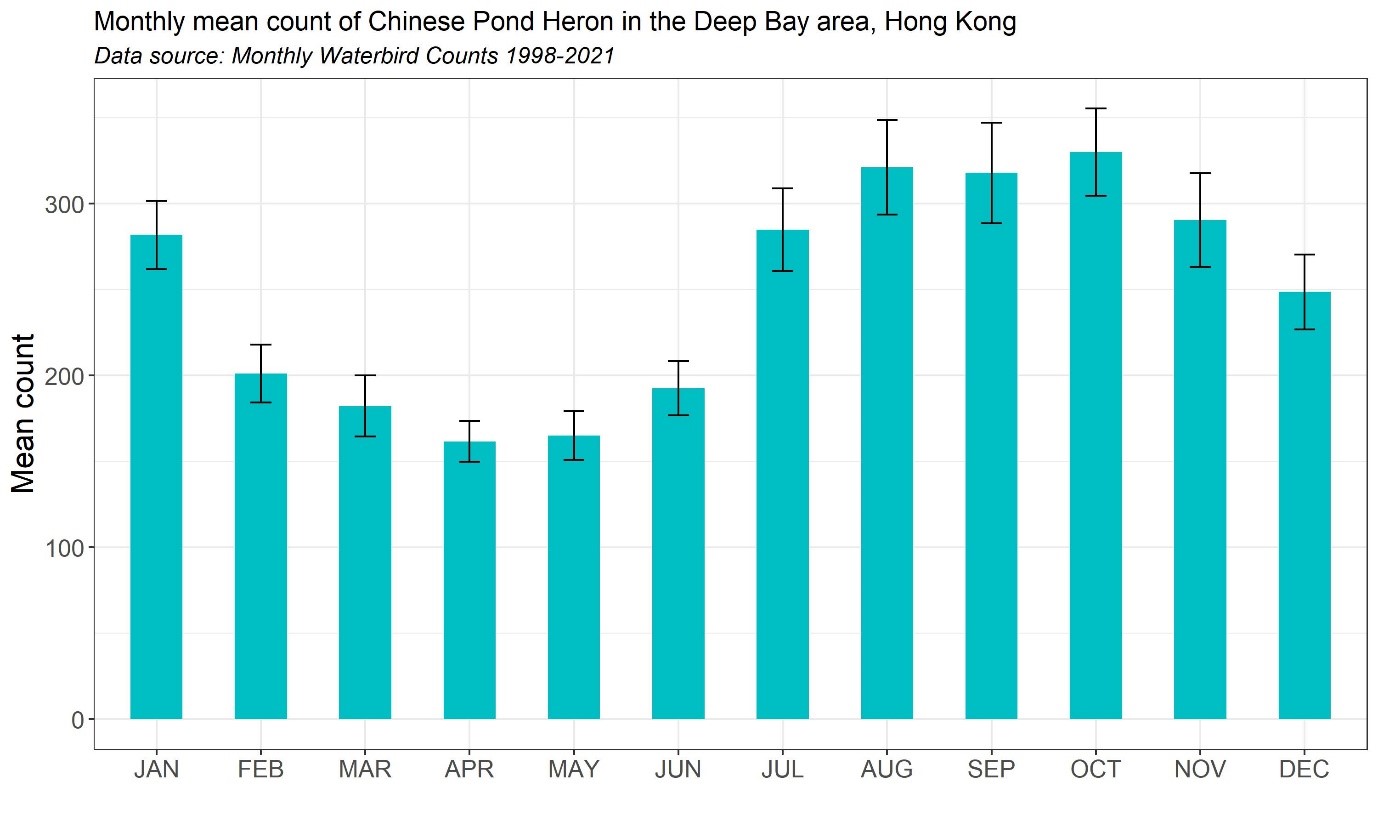
Figure 2.
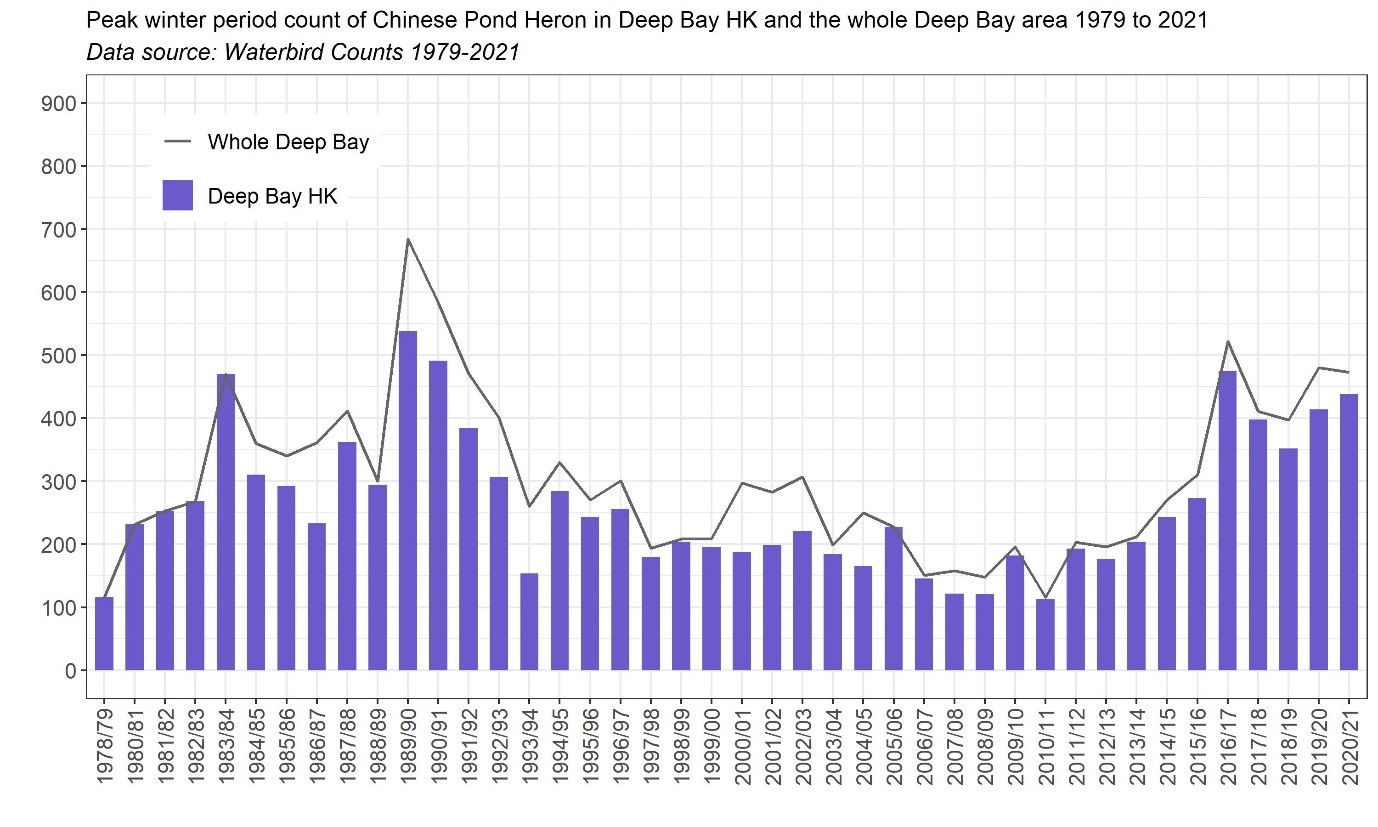
Figure 3.
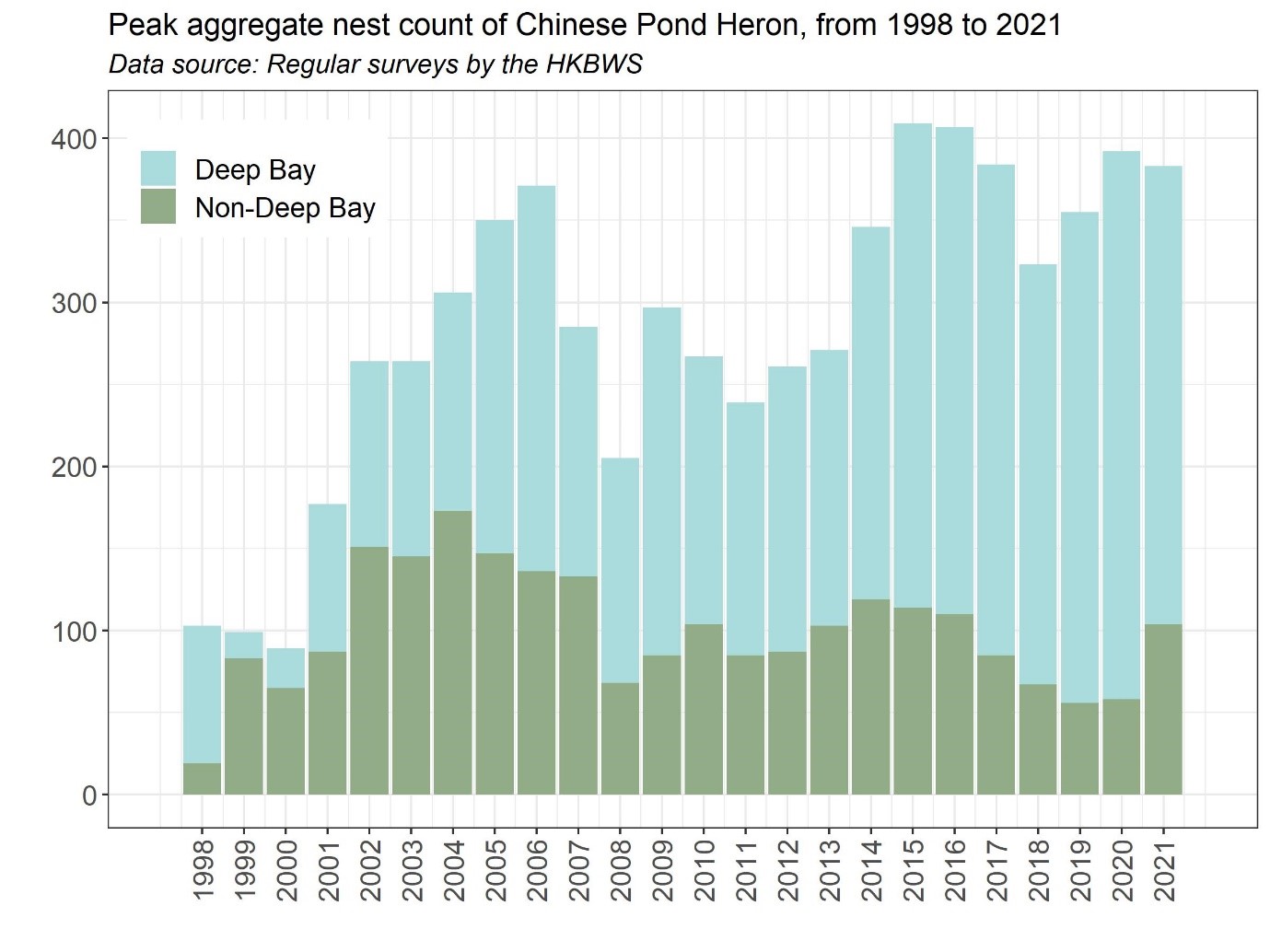
Herklots, G. A. C. (1953). Hong Kong Birds. South China Morning Post, Hong Kong.
Herklots, G. A. C. (1967). Hong Kong Birds (2nd ed.). South China Morning Post, Hong Kong.
Liu, Y. and Y. H. Chen (eds) (2020). The CNG Field Guide to the Birds of China (in Chinese). Hunan Science and Technology Publication House, Changsha.
Macfarlane, A. M. and A. D. Macdonald, revised by Caunter, J. R. L. and A. M. Macfarlane (1966). An Annotated Check-list of the Birds of Hong Kong. Hong Kong Bird Watching Society, Hong Kong.
Martínez-Vilalta, A., A. Motis, and G. M. Kirwan (2020). Chinese Pond-Heron (Ardeola bacchus), version 1.0. In Birds of the World (J. del Hoyo, A. Elliott, J. Sargatal, D. A. Christie, and E. de Juana, Editors). Cornell Lab of Ornithology, Ithaca, NY, USA. https://doi.org/10.2173/bow.chpher1.01
Melville, D. S. (1980). The bird strike problem at Kai Tak Airport, Hong Kong. Final summary report 1974-1979. Agriculture and Fisheries Department, Hong Kong.
Melville, D. S. (1987). Chinese Pond Herons Ardeola bacchus eating flies. Hong Kong Bird Report 1989: 140-141.
Melville, D. S. (1990). Cattle Egrets and Chinese Pond Herons feeding in trees. Hong Kong Bird Report 1986: 104-106.
Melville, D. S. (1995). Chinese Pond Herons eating a Swallow. Hong Kong Bird Report 1994: 216.
Murton, R. K. (1972). The ecology and status of Swinhoe’s Egret, with notes on other herons of south-eastern China. Biological Conservation 4: 89-96.
Sung, Y. H., C. C. Pang, T. C. H. Li, P. P. Y. Wong and Y. Y. Yu (2021). Ecological Correlates of 20-Year Population Trends of Wintering Waterbirds in Deep Bay, South China. Frontiers in Ecology and Evolution. Published 20 April 2021 doi: 10.3389/fevo.2021.658084
Thrower, S. L. (1984). Hong Kong Country Parks. Government Printer, Hong Kong.
Vaughan, R. E. and K. H. Jones (1913). The birds of Hong Kong, Macao and the West River or Si Kiang in South-East China, with special reference to their nidification and seasonal movements. Ibis 1913: 17-76, 163-201, 351-384.
Young, L. (1994). The ecology of Hong Kong Ardeidae (Aves) with special reference to the Chinese Pond Heron at the Mai Po Marshes Nature Reserve. Unpub. PH.D. thesis. University of Hong Kong, Hong Kong.
Young, L and M. W. Cha (1995). The history and status of egretries in Hong Kong with notes on those in the Pearl River Delta, Guangdong, China. Hong Kong Bird Report 1994: 196-215.

